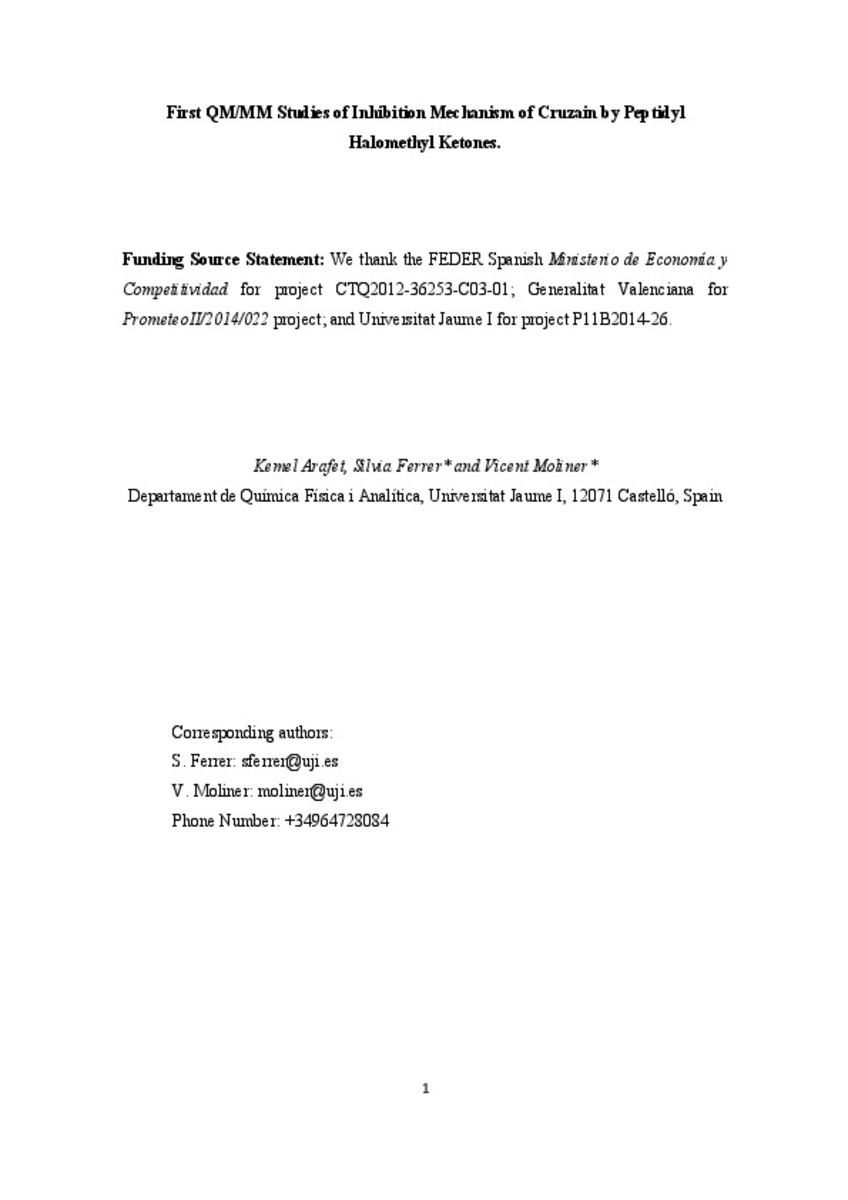Mostrar el registro sencillo del ítem
First Quantum Mechanics/Molecular Mechanics Studies of the Inhibition Mechanism of Cruzain by Peptidyl Halomethyl Ketones
| dc.contributor.author | Arafet Cruz, Kemel | |
| dc.contributor.author | Ferrer Castillo, Silvia | |
| dc.contributor.author | Moliner, Vicent | |
| dc.date.accessioned | 2016-03-22T10:18:35Z | |
| dc.date.available | 2016-03-22T10:18:35Z | |
| dc.date.issued | 2015-05-12 | |
| dc.identifier.citation | ARAFET, Kemel; FERRER, Silvia; MOLINER, Vicent. First Quantum Mechanics/Molecular Mechanics Studies of the Inhibition Mechanism of Cruzain by Peptidyl Halomethyl Ketones. Biochemistry, 2015, vol. 54, no 21, p. 3381-3391. | ca_CA |
| dc.identifier.issn | 0006-2960 | |
| dc.identifier.uri | http://hdl.handle.net/10234/154786 | |
| dc.description.abstract | Cruzain is a primary cysteine protease expressed by the protozoan parasite Trypanosoma cruzi during Chagas disease infection, and thus, the development of inhibitors of this protein is a promising target for designing an effective therapy against the disease. In this paper, the mechanism of inhibition of cruzain by two different irreversible peptidyl halomethyl ketones (PHK) inhibitors has been studied by means of hybrid quantum mechanics/molecular mechanics−molecular dynamics (MD) simulations to obtain a complete representation of the possible free energy reaction paths. These have been traced on free energy surfaces in terms of the potential of mean force computed at AM1d/MM and DFT/MM levels of theory. An analysis of the possible reaction mechanisms of the inhibition process has been performed showing that the nucleophilic attack of an active site cysteine, Cys25, on a carbon atom of the inhibitor and the cleavage of the halogen−carbon bond take place in a single step. PClK appears to be much more favorable than PFK from a kinetic point of view. This result would be in agreement with experimental studies in other papain-like enzymes. A deeper analysis of the results suggests that the origin of the differences between PClK and PFK can be the different stabilizing interactions established between the inhibitors and the residues of the active site of the protein. Any attempt to explore the viability of the inhibition process through a stepwise mechanism involving the formation of a thiohemiketal intermediate and a three-membered sulfonium intermediate has been unsuccessful. Nevertheless, a mechanism through a protonated thiohemiketal, with participation of His159 as a proton donor, appears to be feasible despite showing higher free energy barriers. Our results suggest that PClK can be used as a starting point to develop a proper inhibitor of cruzain. | ca_CA |
| dc.description.sponsorShip | We thank the FEDER Spanish Ministerio de Economia y ́ Competitividad for Project CTQ2012-36253-C03-01, Generalitat Valenciana for the PrometeoII/2014/022 project, and Universitat Jaume I for Project P11B2014-26. K.A. thanks the Spanish Ministerio de Economia y Competitividad for a ́ predoctoral contract. | ca_CA |
| dc.format.extent | 11 p. | ca_CA |
| dc.format.mimetype | application/pdf | ca_CA |
| dc.language.iso | eng | ca_CA |
| dc.publisher | ACS Publications | ca_CA |
| dc.relation.isPartOf | Biochemistry, 2015, vol. 54, no 21 | ca_CA |
| dc.rights | Copyright © 2015 American Chemical Society | ca_CA |
| dc.rights.uri | http://rightsstatements.org/vocab/InC/1.0/ | * |
| dc.subject | Chagas disease | ca_CA |
| dc.subject | PHK inhibitors | ca_CA |
| dc.subject | QM/MM | ca_CA |
| dc.subject | Molecular Dynamics | ca_CA |
| dc.subject | PMF | ca_CA |
| dc.title | First Quantum Mechanics/Molecular Mechanics Studies of the Inhibition Mechanism of Cruzain by Peptidyl Halomethyl Ketones | ca_CA |
| dc.type | info:eu-repo/semantics/article | ca_CA |
| dc.identifier.doi | http://dx.doi.org/10.1021/bi501551g | |
| dc.rights.accessRights | info:eu-repo/semantics/openAccess | ca_CA |
| dc.relation.publisherVersion | http://pubs.acs.org/doi/abs/10.1021/bi501551g | ca_CA |
| dc.type.version | info:eu-repo/semantics/acceptedVersion | ca_CA |
Ficheros en el ítem
Este ítem aparece en la(s) siguiente(s) colección(ones)
-
QFA_Articles [817]
Articles de publicacions periòdiques








